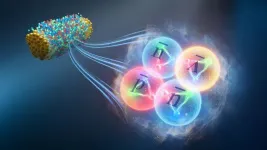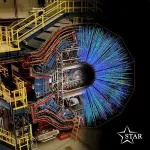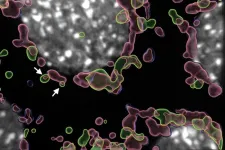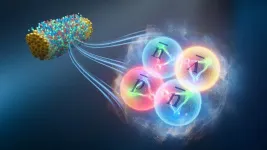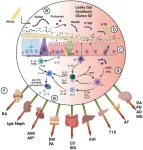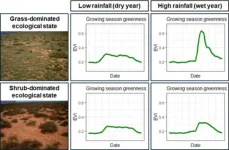(Press-News.org) UPTON, N.Y. — Scientists studying the tracks of particles streaming from six billion collisions of atomic nuclei at the Relativistic Heavy Ion Collider (RHIC) — an “atom smasher” that recreates the conditions of the early universe — have discovered a new kind of antimatter nucleus, the heaviest ever detected. Composed of four antimatter particles — an antiproton, two antineutrons, and one antihyperon — these exotic antinuclei are known as antihyperhydrogen-4.
Members of RHIC’s STAR Collaboration made the discovery by using their house-sized particle detector to analyze details of the collision debris. They report their results in the journal Nature and explain how they’ve already used these exotic antiparticles to look for differences between matter and antimatter.
“Our physics knowledge about matter and antimatter is that, except for having opposite electric charges, antimatter has the same properties as matter — same mass, same lifetime before decaying, and same interactions,” said STAR collaborator Junlin Wu, a graduate student at the Joint Department for Nuclear Physics, Lanzhou University and Institute of Modern Physics, China. But the reality is that our universe is made of matter rather than antimatter, even though both are believed to have been created in equal amounts at the time of the Big Bang some 14 billion years ago.
“Why our universe is dominated by matter is still a question, and we don’t know the full answer,” Wu said.
RHIC, a U.S. Department of Energy (DOE) Office of Science user facility for nuclear physics research at DOE’s Brookhaven National Laboratory, is a good place to study antimatter. Its collisions of heavy ions — atomic nuclei that have been stripped of their electrons and accelerated close to the speed of light — melt the boundaries of the ions’ individual protons and neutrons. The energy deposited in the resulting soup of free quarks and gluons, visible matter’s most fundamental building blocks, generates thousands of new particles. And like the early universe, RHIC makes matter and antimatter in nearly equal amounts. Comparing characteristics of matter and antimatter particles generated in these particle smashups might offer clues to some asymmetry that tipped the balance to favor the existence of matter in today’s world.
Detecting heavy antimatter
“To study the matter-antimatter asymmetry, the first step is to discover new antimatter particles,” said STAR physicist Hao Qiu, Wu’s advisor at IMP. “That’s the basic logic behind this study.”
STAR physicists had previously observed nuclei made of antimatter created in RHIC collisions. In 2010, they detected the antihypertriton. This was the first instance of an antimatter nucleus containing a hyperon, which is a particle containing at least one “strange” quark rather than just the lighter “up” and “down” quarks that make up ordinary protons and neutrons. Then, just a year later, STAR physicists toppled that heavyweight antimatter record by detecting the antimatter equivalent of the helium nucleus: antihelium-4.
A more recent analysis suggested that antihyperhydrogen-4 might also be within reach. But detecting this unstable antihypernucleus — where the addition of an antihyperon (specifically an antilambda particle) in place of one of the protons in antihelium would edge out the heavyweight record holder once again — would be a rare event. It would require all four components — one antiproton, two antineutrons, and one antilambda — to be emitted from the quark-gluon soup generated in RHIC collisions in just the right place, headed in the same direction, and at the right time to clump together into a temporarily bound state.
“It is only by chance that you have these four constituent particles emerge from the RHIC collisions close enough together that they can combine to form this antihypernucleus,” said Brookhaven Lab physicist Lijuan Ruan, one of two co-spokespersons for the STAR Collaboration.
Needle in a “pi” stack
To find antihyperhydrogen-4, the STAR physicists looked at the tracks of the particles this unstable antihypernucleus decays into. One of those decay products is the previously detected antihelium-4 nucleus; the other is a simple positively charged particle called a pion (pi+).
“Since antihelium-4 was already discovered in STAR, we used the same method used previously to pick up those events and then reconstructed them with pi+ tracks to find these particles,” Wu said.
By reconstruct, he means retracing the trajectories of the antihelium-4 and pi+ particles to see if they emerged from a single point. But RHIC smashups produce a lot of pions. And to find the rare antihypernuclei, the scientists were sifting through billions of collision events! Each antihelium-4 emerging from a collision could be paired with hundreds or even 1,000 pi+ particles.
“The key was to find the ones where the two particle tracks have a crossing point, or decay vertex, with particular characteristics,” Ruan said. That is, the decay vertex has to be far enough from the collision point that the two particles could have originated from the decay of an antihypernucleus formed just after the collision from particles initially generated in the fireball.
The STAR team worked hard to rule out the background of all the other potential decay pair partners. In the end, their analysis turned up 22 candidate events with an estimated background count of 6.4.
“That means around six of the ones that look like decays from antihyperhydrogen-4 may just be random noise,” said Emilie Duckworth, a doctoral student at Kent State University whose role was to ensure that the computer code used to sift through all those events and pick out the signals was written properly.
Subtracting that background from 22 gives the physicists confidence they’ve detected about 16 actual antihyperhydrogen-4 nuclei.
Matter-antimatter comparison
The result was significant enough for the STAR team to do some direct matter-antimatter comparisons.
They compared the lifetime of antihyperhydrogen-4 with that of hyperhydrogen-4, which is made of the ordinary-matter varieties of the same building blocks. They also compared lifetimes for another matter-antimatter pair: the antihypertriton and the hypertriton.
Neither showed a significant difference, which did not surprise the scientists.
The experiments, they explained, were a test of a particularly strong form of symmetry. Physicists generally agree that a violation of this symmetry would be extremely rare and will not hold the answer to the matter-antimatter imbalance in the universe.
“If we were to see a violation of [this particular] symmetry, basically we’d have to throw a lot of what we know about physics out the window,” Duckworth said.
So, in this case, it was sort of comforting that the symmetry still works. The team agreed the results further confirmed that physicists’ models are correct and are “a great step forward in the experimental research on antimatter.”
The next step will be to measure the mass difference between the particles and antiparticles, which Duckworth, who was selected in 2022 to receive funding from the DOE Office of Science Graduate Student Research program, is pursuing.
This work was supported by the DOE Office of Science, the U.S. National Science Foundation, and a range of international agencies and organizations listed in the scientific paper. The researchers made use of computing resources in the Scientific Data and Computing Center at Brookhaven Lab, the National Energy Research Scientific Computing Center (NERSC) at DOE’s Lawrence Berkeley National Laboratory, and the Open Science Grid consortium. NERSC is another DOE Office of Science user facility.
Brookhaven National Laboratory is supported by the Office of Science of the U.S. Department of Energy. The Office of Science is the single largest supporter of basic research in the physical sciences in the United States and is working to address some of the most pressing challenges of our time. For more information, visit science.energy.gov.
Follow @BrookhavenLab on social media. Find us on Instagram, LinkedIn, X, and Facebook.
Related Links
Scientific paper: "Observation of the Antimatter Hypernucleus 4/(anti)Λ(anti)H"
'Strange' Glimpse into Neutron Stars and Symmetry Violation
RHIC Physicists Nab New Record for Heaviest Antimatter
Exotic Antimatter Detected at Relativistic Heavy Ion Collider (RHIC) END
New heaviest exotic antimatter nucleus
Scientists teasing through six billion particle smashups detect roughly 16 "antihyperhydrogen-4" particles
2024-08-21
ELSE PRESS RELEASES FROM THIS DATE:
Virtual learning in kindergarten through grade 12 during the COVID-19 pandemic and chronic absenteeism
2024-08-21
About The Study: Chronic absenteeism rates were substantially higher in school districts that used virtual learning during the COVID-19 pandemic compared with in person in this cross-sectional study. Understanding how to reduce chronic absenteeism and use virtual learning without potentially negative consequences are key policy questions moving forward.
Corresponding Author: To contact the corresponding author, William N. Evans, PhD, email wevans1@nd.edu.
To access the embargoed study: ...
Self-repairing mitochondria use novel recycling system, study finds
2024-08-21
Mitochondria, the so-called “powerhouse of the cell,” depend on a newly discovered recycling mechanism identified by scientists at The Hospital for Sick Children (SickKids).
Mitochondria are tiny structures inside of cells that carry out a wide range of critical functions, including generating energy to help keep cells healthy. Every mitochondrion has two layers of membranes: the outer membrane and the inner membrane. On the inner membrane, folds called cristae contain proteins and molecules needed for energy production. ...
Mobile species are ‘glue’ which connect different habitats together, study finds
2024-08-21
A groundbreaking study conducted across 30 field sites in the southwest UK has revealed the importance of incorporating varied habitats into the landscape at large.
The research, published today in Nature and led by ecologists at the University of Bristol, addresses critical questions in conservation and land management, shedding new light on species interactions and how food chains operate across multiple habitats.
The study found significant differences in food web structures among landscapes with one, two, or three habitats, including a more evenly distributed abundance of species. Multi-habitat landscapes host a higher number ...
Physicists discover heaviest antimatter hypernucleus to date
2024-08-21
Physicists from the STAR Collaboration have observed a new antimatter hypernucleus, antihyperhydrogen-4, for the first time. This is the heaviest antimatter hypernucleus discovered in experiments to date. This study, led by researchers from the Institute of Modern Physics (IMP) of the Chinese Academy of Sciences, was published in Nature on Aug. 21.
Current physics assumes that the properties of matter and antimatter are symmetrical and that equal amounts of matter and antimatter existed at the birth of the universe. However, some mysterious physical mechanism caused the annihilation of most matter and antimatter, with only about one in ten billion matter particles ...
Pediatric functional gastrointestinal disorders: pathophysiology, diagnosis and management
2024-08-21
Functional Gastrointestinal Disorders (FGIDs), also known as disorders of gut-brain interaction, encompass a wide range of conditions that cannot be attributed to structural, biochemical, or organic abnormalities. These disorders vary significantly from infancy to adulthood, with distinct manifestations in neonates/toddlers and children/adolescents. The ROME criteria, updated periodically, currently in use is ROME IV, which facilitates early and accurate diagnosis of FGIDs. Despite their prevalence, pediatric FGIDs pose diagnostic and therapeutic challenges due to children's inability to articulate symptoms and the influence ...
Gluten is a proinflammatory inducer of autoimmunity
2024-08-21
The interaction between humans and their environment, mediated by nutrition, plays a crucial role in regulating inflammatory responses. Chronic inflammatory diseases have been on the rise, and the scientific community has been actively exploring pro-inflammatory nutrients as potential therapeutic targets. Gluten, a major component of wheat, barley, and rye, has been implicated in numerous health issues, particularly celiac disease (CD). This review essay summarizes the key findings of a recent study published in the Journal of Translational Gastroenterology, focusing on the proinflammatory effects of gluten and its implications in autoimmunity.
Gluten and ...
Eyes in the sky and on the ground: enhanced dryland monitoring with remote sensing
2024-08-21
While animals in drylands hone their natural senses to find vegetation, humans have developed “external eyes” to track these vital resources.
Scientists from the U.S. Department of Agriculture (USDA) Agricultural Research Service (ARS) have created an advanced method that integrates high-frequency near-surface camera data with broader satellite imagery to better monitor and assess dryland ecosystems. Their approach could aid in taking timely action to prevent land degradation, contributing to improved environmental management and conservation strategies.
Their results were published in the Journal of Remote Sensing on July 8.
Drylands, including ...
New Data: MedPearl clinical decision platform improves specialty referrals, boosts productivity, and reduces clinician time spent in the EMR
2024-08-21
Data published today in the New England Journal of Medicine Catalyst reported that MedPearl, a Providence-developed clinician-built clinical decision platform, improves primary care clinician productivity, decreases time waste on administrative tasks and improves the quality of referrals sent to specialists.
The paper details operational outcomes from MedPearl’s use among more than 4,000 active monthly clinician users and shows statistically significant improvement in total productivity, after-hours time spent in the EMR and incremental margin per referral ...
Kessler Foundation scientists investigate effects of robotic postural stand training combined with spinal cord epidural stimulation
2024-08-21
East Hanover, NJ – August 21, 2024 – Kessler Foundation researchers have published a new clinical study investigating the effects of robotic postural stand training combined with spinal cord epidural stimulation (Stand-scES) on trunk control in individuals with high-level spinal cord injury (SCI). The open access article, “Effects of Robotic Postural Stand Training with Epidural Stimulation on Sitting Postural Control in Individuals with Spinal Cord Injury: A Pilot Study” (doi.org/10.3390/jcm13154309) was published in the Journal of Clinical ...
New center to improve robot dexterity selected to receive up to $52 million
2024-08-21
PITTSBURGH - Carnegie Mellon University will be a core partner in a new multi-institutional collaboration that has received $26 million from the National Science Foundation to launch an Engineering Research Center (ERC) dedicated to revolutionizing the ability of robots to amplify human labor.
Nine Carnegie Mellon University faculty members, with expertise ranging from Softbotics, engineering, and computer science to psychology, and diversity and inclusion, will help to develop highly dexterous robotic hands, user-friendly interfaces, ...
LAST 30 PRESS RELEASES:
Bharat Innovates 2026 National Basecamp Showcases India’s Most Promising Deep-Tech Ventures
Here’s what determines whether your income level rises or falls
SCIE indexation achievement: Celebrate with Space: Science & Technology
Children’s Hospital Colorado performs region’s first pediatric heart and liver dual organ transplant
Australian team discover why quantum computers have memory problems over time
What determines the fate of a T cell?
Candida auris: genetic process revealed which could be treatment target for deadly fungal disease
Groundbreaking discovery turns household plastic recycling into anti-cancer medication
Blocking a key inflammatory pathway improves liver structure and vascular function in cirrhosis, study finds
Continuous spread: Raccoon roundworm detected in nine European countries
HKUST Engineering researchers developed a novel photodetector to enhance the performance of on-chip light monitoring
Strategic river sensors could have forewarned of Texas Camp flood disaster
Drone sampling of whale breath reveals first evidence of potentially deadly virus in Arctic
Roman soldiers defending Hadrian’s Wall infected by parasites, study finds
Pinochet’s prisoners were tormented with music but still found solace in it, a new book reveals
Fertility remains high in rural Tanzania despite access to family planning
AI-assisted device can improve autism care access
Kinetic careers
Uncovering how parasitic plants avoid attacking themselves to improve crop resistance
Nanoparticle vaccine strategy could protect against Ebola and other deadly filoviruses
Study finds brain care score can predict risk of stroke across racial groups
Key lung immune cells can intensify allergic reactions
Do hormones explain why women experience more gut pain?
New materials conduct ions in solids as easily as in liquids
Breakthrough of the Year: Renewable energy begins to eclipse fossil fuel-based sources
LLM use is reshaping scientific enterprise by increasing output, reducing quality and more
Introducing LightGen, a chip for ultra-fast, ultra-efficient generative AI
Astronomers see fireworks from violent collisions around nearby star
ACC/AHA issue new guideline on managing congenital heart disease in adults
Cosmic crash caught on camera
[Press-News.org] New heaviest exotic antimatter nucleusScientists teasing through six billion particle smashups detect roughly 16 "antihyperhydrogen-4" particles
